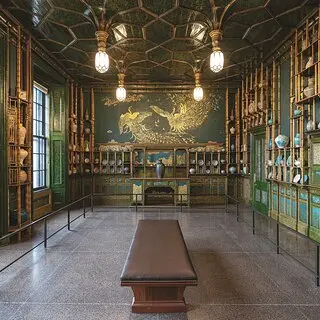
The Peacock Room Takes Flight Again After Restoration
The Peacock Room, a permanent installation at the Smithsonian’s National Museum of Asian Art, reopened in September of 2022 after a round of repairs and a deep cleaning. Designed in 1876 by architect Thomas Jeckyll and American painter James McNeill Whistler for shipping magnate Frederick Leyland’s London house, the Peacock Room was deconstructed in 1904 and sent to Detroit, where its new owner, industrialist Charles Lang Freer, used it as a space for entertaining. Freer bequeathed it to the Smithsonian, where Washington, D.C., museumgoers have admired the striking blue-and-green walls and the golden depictions of the room’s eponymous fowl since 1923.
Nearly a century and multiple restorations later, the museum’s objects conservator, Ellen Chase, and exhibits conservator, Jenifer Bosworth, determined that a substantial cleaning was in order. They also discovered that the room’s shutters—which are opened the third Thursday of every month—were catching on the sills, damaging both components.
With the aid of several conservation firms, Bosworth and Chase completed the work in two phases. First, crews sanded the bottom of the shutters where needed; realigned split moldings around the windows; removed adhesive from decorative metal floor vents, to which they applied a protective coating; and made other repairs. The next phase involved cleaning various painted surfaces, including leather, canvas, and wood. Polyurethane sponges were used to gently scrub gilded spindles, deionized water worked best on wood panels and canvas surfaces, and simple brushing did the trick for the upper portions of the leather walls. Bosworth says that after the treatment, the room “sparkled a lot more than I had expected, and that was very gratifying.”


